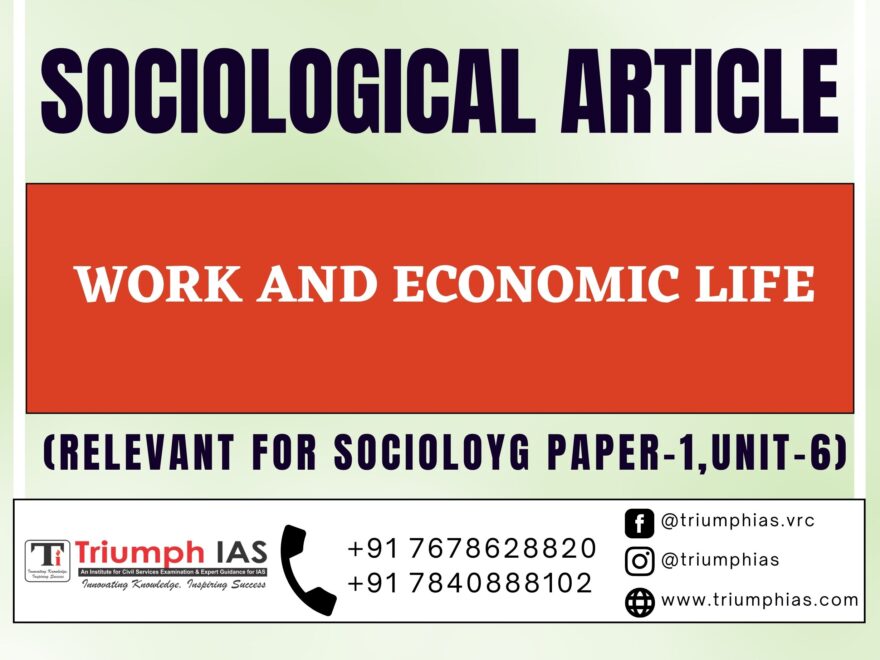Work and economic life
(Relevant for GS Paper-1,Unit-6)

The precarious existence of laborers in India
- India’s industrial development and economic expansion have led to an undesirable side effect: an alarming increase in incidents at work.
- Numerous lives are either ended prematurely or permanently changed due to insufficient work safety protocols and risky work environments.
- Based on certain statistics, about half of the vacancies for roles such as Safety Inspectors, Medical Inspectors, Hygiene Inspectors, and Chemical Inspectors are yet to be filled. This shortage of staff not only complicates accurate data gathering, but it also hinders effective inspections.
- Thirdly, the growing informalization of the economy has already forced many MSMEs out of the formal sector, contributing to 90% of the GDP. Consequently, only 22% of all registered factories and 35% of perilous factories are subjected to inspections. The lion’s share of MSMEs, representing 33% of India’s GDP, operate without any safety regulations.
- Work, as conceptualized by sociologists, is the execution of tasks requiring mental and physical effort, aimed at the production of goods and services that satisfy human needs. An occupation, or job, is a form of work performed in return for a consistent income or wage.
- The roots of the sociology of work can be traced back to the seminal works of classical sociologists. Karl Marx, Emile Durkheim, and Max Weber all considered the study of contemporary work central to sociology. Marx was the pioneer social theorist who intensively investigated factory work conditions emerging during the industrial revolution, probing into how the shift from independent craftsmanship to factory work under a supervisor led to alienation and deskilling.
- Contrarily, Durkheim was interested in how societies maintain stability via norms, customs, and traditions as work and industry undergo changes during the industrial revolution. Weber’s focus was on the rise of new forms of authority within modern bureaucratic institutions.
Formal Organizations
The official framework of a group or organization consists of a predetermined set of procedural rules and structures, typically documented in writing. These rules are expressed in a language that purportedly leaves little room for subjective interpretation.
Characteristic
Precise rules and regulations, a structured organization, set goals and policies, among other features.
Informal Organization
The informal organization is the interconnected social framework that dictates how individuals cooperate in real-world scenarios.
It represents the sum of behaviors, interactions, standards, and personal/professional links that facilitate task completion and relationship development among people.
It embodies a fluid collection of personal bonds, social networks, interest-based communities, and emotional drives for motivation.
The informal organization naturally adapts in response to shifts in the working atmosphere, the ebb and flow of individuals across its permeable borders, and the intricate social interactions among its members.
An informal organization is marked by continual change; originating at the grassroots level; being flexible and reactive; necessitating internal understanding for recognition; acknowledging people as unique individuals; exhibiting a flat and adaptable structure; being bound together by trust and mutual exchange; and presenting a challenge to precisely define.
Follow us :
-
🔎 https://www.instagram.com/triumphias
🔎https://www.youtube.com/c/TriumphIAS
https://t.me/VikashRanjanSociology
Find More Blogs
Scope of the subject and comparison with other social sciences
Changing family structure in India Modernity and social changes in Europe
India’s economy, labor conditions in India, formal organizations, informal organizations, sociology of work, industrial development, MSMEs, workplace safety, organizational structures, economic expansion, Indian labor market, workplace incidents, Karl Marx, Emile Durkheim, Max Weber, industrial revolution, job safety#Sociologyforupsc #sociologyforupscinhindi #sociologyforupscgs1 #sociologyforupscprelims #sociologyforupscinenglish #sociologyforupscmainsinhindi #sociologyforupscoptionalinhindi #sociologyforupscmains #sociologyforupscplaylist #sociologyforupsclecture1 #sociologyforupsccse #sociologyforupscoptional #syllabusofsociologyforupscoptional #bestbookforsociologyforupsc #sociologyoptionalforupscanswerwriting #sociologyoptionalforupscanukumari #sociologyoptionalforupscabhijeet #sociologyoptionalforupscanalysis #sociologyoptionalforupscalllectures #sociologysyllabusforupscanalysis

